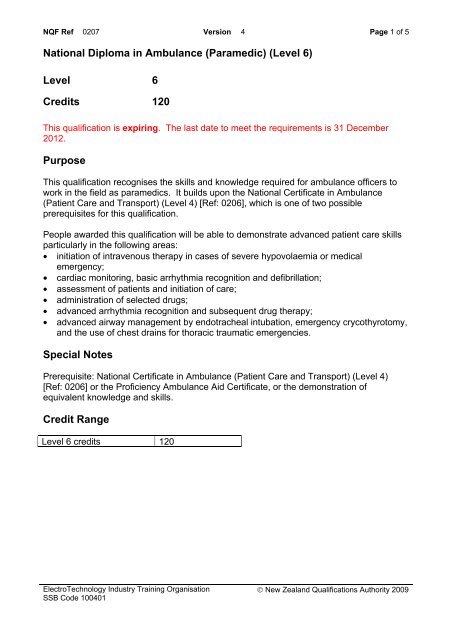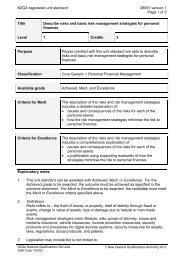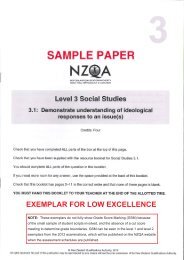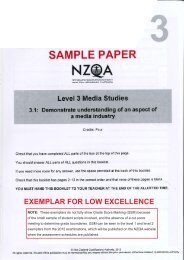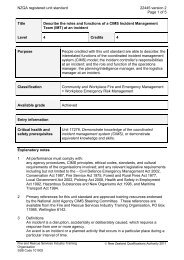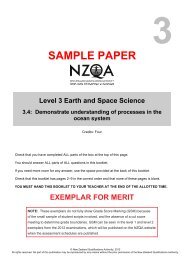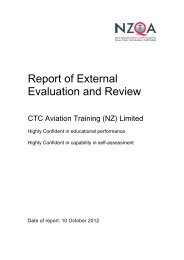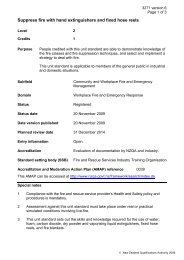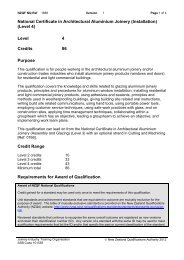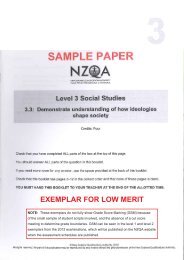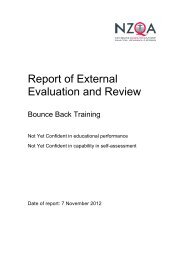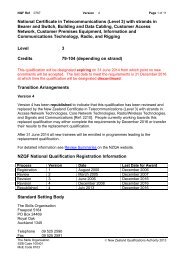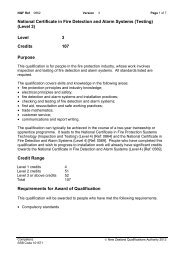National Diploma in Ambulance (Paramedic) (Level 6) Level ... - NZQA
National Diploma in Ambulance (Paramedic) (Level 6) Level ... - NZQA
National Diploma in Ambulance (Paramedic) (Level 6) Level ... - NZQA
Create successful ePaper yourself
Turn your PDF publications into a flip-book with our unique Google optimized e-Paper software.
NQF Ref 0207 Version 4 Page 1 of 5<br />
<strong>National</strong> <strong>Diploma</strong> <strong>in</strong> <strong>Ambulance</strong> (<strong>Paramedic</strong>) (<strong>Level</strong> 6)<br />
<strong>Level</strong> 6<br />
Credits 120<br />
This qualification is expir<strong>in</strong>g. The last date to meet the requirements is 31 December<br />
2012.<br />
Purpose<br />
This qualification recognises the skills and knowledge required for ambulance officers to<br />
work <strong>in</strong> the field as paramedics. It builds upon the <strong>National</strong> Certificate <strong>in</strong> <strong>Ambulance</strong><br />
(Patient Care and Transport) (<strong>Level</strong> 4) [Ref: 0206], which is one of two possible<br />
prerequisites for this qualification.<br />
People awarded this qualification will be able to demonstrate advanced patient care skills<br />
particularly <strong>in</strong> the follow<strong>in</strong>g areas:<br />
• <strong>in</strong>itiation of <strong>in</strong>travenous therapy <strong>in</strong> cases of severe hypovolaemia or medical<br />
emergency;<br />
• cardiac monitor<strong>in</strong>g, basic arrhythmia recognition and defibrillation;<br />
• assessment of patients and <strong>in</strong>itiation of care;<br />
• adm<strong>in</strong>istration of selected drugs;<br />
• advanced arrhythmia recognition and subsequent drug therapy;<br />
• advanced airway management by endotracheal <strong>in</strong>tubation, emergency crycothyrotomy,<br />
and the use of chest dra<strong>in</strong>s for thoracic traumatic emergencies.<br />
Special Notes<br />
Prerequisite: <strong>National</strong> Certificate <strong>in</strong> <strong>Ambulance</strong> (Patient Care and Transport) (<strong>Level</strong> 4)<br />
[Ref: 0206] or the Proficiency <strong>Ambulance</strong> Aid Certificate, or the demonstration of<br />
equivalent knowledge and skills.<br />
Credit Range<br />
<strong>Level</strong> 6 credits 120<br />
ElectroTechnology Industry Tra<strong>in</strong><strong>in</strong>g Organisation<br />
SSB Code 100401<br />
© New Zealand Qualifications Authority 2009
NQF Ref 0207 Version 4 Page 2 of 5<br />
Requirements for Award of Qualification<br />
Award of NQF Qualifications<br />
Credit ga<strong>in</strong>ed for a standard may be used only once to meet the requirements of this qualification.<br />
Unit standards and achievement standards that are equivalent <strong>in</strong> outcome are mutually exclusive for the<br />
purpose of award. The table of mutually exclusive standards is provided <strong>in</strong> section 7 of the New Zealand<br />
Qualifications Authority (<strong>NZQA</strong>) Rules and Procedures publications available at<br />
http://www.nzqa.govt.nz/ncea/acrp/<strong>in</strong>dex.html.<br />
Reviewed standards that cont<strong>in</strong>ue to recognise the same overall outcome are registered as new versions<br />
and reta<strong>in</strong> their identification number (ID). Any version of a standard with the same ID may be used to meet<br />
qualification requirements that list the ID and/or that specify the past or current classification of the standard.<br />
Summary of Requirements<br />
• Compulsory standards<br />
Detailed Requirements<br />
Compulsory<br />
The follow<strong>in</strong>g standards are required<br />
Health > Emergency Services > <strong>Ambulance</strong><br />
ID Title <strong>Level</strong> Credit<br />
6226 Adm<strong>in</strong>ister drugs <strong>in</strong> ambulance services 6 30<br />
6229 Manage acute cardiac events <strong>in</strong> ambulance services 6 15<br />
6234 Treat hypovolaemic shock <strong>in</strong> ambulance services 6 15<br />
6235 Assess patients and <strong>in</strong>itiate paramedic care <strong>in</strong><br />
ambulance services<br />
6517 Manage life threaten<strong>in</strong>g airway and ventilation<br />
emergencies <strong>in</strong> ambulance services<br />
6 30<br />
6 30<br />
Transition Arrangements<br />
Version 4<br />
Version 4 was issued to <strong>in</strong>dicate that this qualification is expir<strong>in</strong>g.<br />
For detailed <strong>in</strong>formation see Review Summaries on the <strong>NZQA</strong> website.<br />
Previous versions of the qualification<br />
Version 3 was updated to reflect the change of standard sett<strong>in</strong>g responsibility from the<br />
New Zealand <strong>Ambulance</strong> Education Council to the ElectroTechnology Industry Tra<strong>in</strong><strong>in</strong>g<br />
Organisation <strong>in</strong> July 2004.<br />
ElectroTechnology Industry Tra<strong>in</strong><strong>in</strong>g Organisation<br />
SSB Code 100401<br />
© New Zealand Qualifications Authority 2009
NQF Ref 0207 Version 4 Page 3 of 5<br />
Version 2 was registered follow<strong>in</strong>g the review of the <strong>Ambulance</strong> standards. The structure<br />
of the qualification was not changed.<br />
Version 1 of this qualification replaced the Post-Proficiency Module (Intravenous Therapy),<br />
the Post-Proficiency Module (Monitor<strong>in</strong>g and Defibrillation), and the Certificate <strong>in</strong><br />
Advanced <strong>Ambulance</strong> Aid (<strong>Paramedic</strong>) <strong>in</strong> March 1996. Transition arrangements for those<br />
qualifications expired <strong>in</strong> June 1996.<br />
The ambulance <strong>in</strong>dustry will cont<strong>in</strong>ue to recognise the Post-proficiency Modules <strong>in</strong><br />
Intravenous Therapy and <strong>in</strong> Monitor<strong>in</strong>g and Defibrillation, and the Certificate <strong>in</strong> Advanced<br />
<strong>Ambulance</strong> Aid (<strong>Paramedic</strong>) as valid qualifications for work<strong>in</strong>g as an ambulance officer.<br />
For more <strong>in</strong>formation please contact the ElectroTechnology Industry Tra<strong>in</strong><strong>in</strong>g Organisation<br />
(ETITO).<br />
NQF Registration Information<br />
Process Version Date Last Date for Assessment<br />
Registration 1 September 1996 December 2012<br />
Review 2 August 1999 December 2012<br />
Revision 3 March 2006 December 2012<br />
Review 4 November 2009 December 2012<br />
Standard Sett<strong>in</strong>g Body<br />
ElectroTechnology Industry Tra<strong>in</strong><strong>in</strong>g Organisation<br />
FREEPOST 5164<br />
PO Box 24469<br />
Royal Oak<br />
Auckland 1345<br />
Telephone 09 525 2590<br />
Email reviewcomments@etito.co.nz<br />
Other standard sett<strong>in</strong>g bodies whose standards are <strong>in</strong>cluded <strong>in</strong> the<br />
qualification<br />
New Zealand <strong>Ambulance</strong> Education Council<br />
Certification<br />
This certificate will display the logos of <strong>NZQA</strong>, the ElectroTechnology Industry Tra<strong>in</strong><strong>in</strong>g<br />
Organisation and the accredited organisation.<br />
ElectroTechnology Industry Tra<strong>in</strong><strong>in</strong>g Organisation<br />
SSB Code 100401<br />
© New Zealand Qualifications Authority 2009
NQF Ref 0207 Version 4 Page 4 of 5<br />
Classification<br />
This qualification is classified accord<strong>in</strong>g to the NQF classification system and the<br />
New Zealand Standard Classification of Education (NZSCED) system as specified below.<br />
NQF Classification<br />
NZSCED<br />
Code Description Code Description<br />
1064 Health > Emergency Services ><br />
<strong>Ambulance</strong><br />
069905 Health > Other Health ><br />
<strong>Paramedic</strong>al Studies<br />
Quality Management Systems<br />
Providers and Industry Tra<strong>in</strong><strong>in</strong>g Organisations must be accredited by a recognised Quality Assurance Body<br />
before they can register credits from assessment aga<strong>in</strong>st standards. Accredited providers and Industry<br />
Tra<strong>in</strong><strong>in</strong>g Organisations assess<strong>in</strong>g aga<strong>in</strong>st standards must engage with the moderation system that applies to<br />
those standards. Accreditation requirements and the moderation system are outl<strong>in</strong>ed <strong>in</strong> the associated<br />
Accreditation and Moderation Action Plan (AMAP) for each standard.<br />
ElectroTechnology Industry Tra<strong>in</strong><strong>in</strong>g Organisation<br />
SSB Code 100401<br />
© New Zealand Qualifications Authority 2009
NQF Ref 0207 Version 4 Page 5 of 5<br />
Prerequisite Diagram<br />
<strong>Level</strong> 4<br />
<strong>National</strong> Certificate <strong>in</strong> <strong>Ambulance</strong><br />
(Patient Care and Transport) (<strong>Level</strong> 4)<br />
[Ref: 0206] or former Proficiency<br />
<strong>Ambulance</strong> Aid Certificate<br />
6229 6234<br />
<strong>Level</strong> 6<br />
6226 6517<br />
6235<br />
Key<br />
Is also a prerequisite for this qualification<br />
ElectroTechnology Industry Tra<strong>in</strong><strong>in</strong>g Organisation<br />
SSB Code 100401<br />
© New Zealand Qualifications Authority 2009


